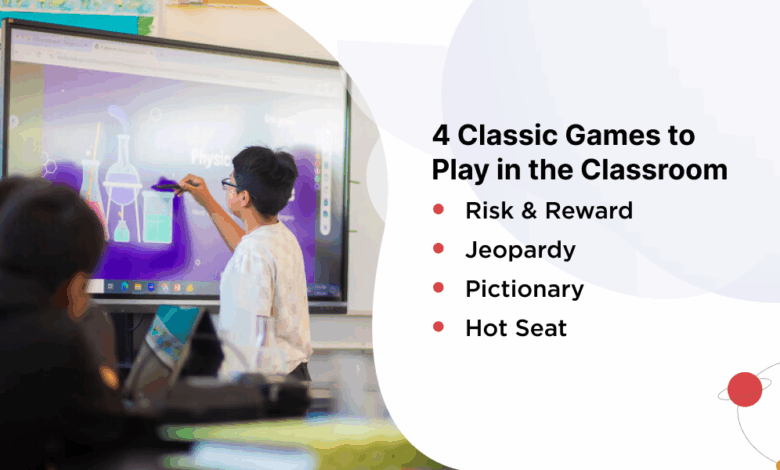7 Games to Play in the Classroom with an Interactive Whiteboard

7 Games to Play in the Classroom with an Interactive Whiteboard
Choosing the right games to play in the classroom can seriously boost lesson quality and student engagement. Studies show that gamified activities improve retention, increase enjoyment, and lift morale—for both teachers and students. Add an interactive whiteboard, and you’re set for unforgettable lessons.
So if you’re ready to spark some excitement in your lessons, read on to learn about 7 games to play in the classroom with your students—or explore ViewBoard Interactive Displays to bring them to life.
Everyone loves to play, no matter their age—and classroom games are the perfect way to capture students’ attention, reinforce concepts, and create inclusive environments for practicing new skills, all while making learning feel effortless. While classroom games once felt limited to end-of-semester or one-off activities, today’s educational environments have fully embraced their genuine educational value.
Why Find Games to Play in the Classroom?
Students naturally absorb information through play. After all, it feels fun, not forced.
That’s why classroom games are such a powerful tool: they boost participation, support social and emotional learning, and even improve academic performance, as Edutopia points out.
Overall, the median student in the group with the games achieved a 69% as opposed to the median student in the other group who achieved a 60%.
University of Warwick
But why exactly are games so effective? Well, they break up routine, keep students actively engaged, and offer hands-on ways to apply knowledge. This makes it easier to spot what’s sinking in and what needs more review.
Fitting games into lessons isn’t always easy—especially when no single activity works for every class and teachers are under time pressure. That’s where interactive whiteboards help. They make it easy to switch things up with flexible, engaging activities, including ready-made or quick-to-launch games that keep students curious without adding to your prep time.
How Games Resonate with Different Types of Learners
Another powerful aspect of classroom games is their ability to appeal to different types of learners. For example, games that utilize an interactive whiteboard engage visual and auditory learners in ways that reading from a textbook or writing essays can’t.
And when there’s a reward involved—even something as simple as a class cheer or leaderboard recognition—students tend to lean in a little more. That extra boost of motivation helps turn content into something memorable, building confidence along the way.

4 Classic Whiteboard Games to Play in the Classroom
You can play plenty of classroom games on a good old analog whiteboard, but an interactive whiteboard, such as ViewSonic ViewBoard interactive displays, adds even more fun. After all, these boards combine multimedia and stylus support with screen-sharing functionality and the ability to utilize and adapt PowerPoint presentations.
Out of the hundreds of possibilities, these four classic whiteboard games are guaranteed to turn any lesson into an educational fun fest:
1. Risk & Reward
Risk & Reward is a fast-paced, team-based game that turns content review into a thrilling challenge—perfect for any interactive whiteboard. The idea is simple: students evaluate a series of statements—math formulas, historical facts, literature quotes, or anything tied to your lesson—and decide whether they’re true or false. The twist? They wager points based on how confident they feel in their answers.
How to Play
- Divide the class into teams and give each team a starting point total (e.g., 20, 100, or 500).
- Display a series of true or false statements on the board. These can be based on your lesson content (math, history, literature, etc.).
- For each statement, teams decide how many points to risk based on their confidence in the answer.
- If they answer correctly, they earn the points they risked.
- If they’re wrong, that amount is subtracted from their total.
- The team with the highest point total at the end of the game wins.
Why It Works
Risk & Reward transforms passive review into an active decision-making challenge. By encouraging students to weigh their knowledge against their confidence, it promotes critical thinking and self-reflection. Plus, the team format encourages discussion, collaboration, and a healthy dose of competition—while reinforcing key lesson content in a way that feels fun.
2. Jeopardy
Inspired by the iconic TV game show, Jeopardy brings friendly competition and critical thinking into the classroom. It’s built around a game board featuring six categories, each with five clues. The clues increase in difficulty as their point value goes up—lower-value clues are easier, while higher-value ones pose more of a challenge.
How to Play
- Set up a game board with six categories, each containing five clues of increasing difficulty and point value.
- Players or teams take turns selecting a category and point value.
- Read the corresponding clue; if the player or team answers correctly, they earn the points.
- An incorrect answer results in a deduction of that point value.
- A correct response allows the same player or team to choose the next clue.
- If they answer incorrectly or run out of time, other players or teams can “buzz in” to try and answer.
- Optional features like Double Jeopardy, Daily Doubles, and Final Jeopardy can be added for extra excitement.
- The team or player with the highest score at the end of the game wins.
Free Jeopardy Classroom Template
Looking for a quick way to bring Jeopardy into your classroom? This free Jeopardy classroom template works great with interactive whiteboards, making setup simple and gameplay smooth. Designed for up to six players or teams, it features real-time score tracking, a question timer, and fully editable slides.
3. Pictionary
Pictionary’s a classic for a reason. It’s fast, fun, and gets the whole class thinking—and laughing—together. Perfect for visual topics or vocab reviews, it only takes a minute to set up with a digital whiteboarding app on an interactive display. Whether you’re recapping a lesson or just breaking up the routine, this one’s a go-to for instant classroom energy.
How to Play
- Divide students into teams or play as one large group.
- One student comes to the board and draws a word or concept related to the lesson topic.
- The rest of the class guesses what the drawing represents.
- No writing of words or giving verbal clues—only drawings are allowed.
- Once the correct answer is guessed, another student takes a turn at the board.
- Use prompts tied to your subject, such as vocabulary words, scientific diagrams, historical figures, or story scenes.
Why It Works
Pictionary reinforces lesson content through action and creativity, making it great for boosting engagement in a modern classroom. It’s especially effective for visual and kinesthetic learners, who benefit from thinking in pictures and moving around. The fast-paced guessing keeps everyone involved, while the drawing element deepens understanding in a playful, low-pressure way.
4. Hot Seat
Hot Seat is a fun, fast-thinking game that gets students talking and thinking on their feet. It’s a great way to add energy to the classroom while giving teachers a chance to observe how students process and explain concepts in their own words.
How to Play
- Set up an interactive whiteboard with slides showing words or images.
- Place a chair—the “hot seat”—at the front of the room, facing the class and away from the board.
- One student at a time sits in the hot seat, unable to see the screen.
- The class gives clues to describe the word or image, but:
- They can’t say the word directly.
- They can’t use rhymes or sound-alike hints.
- The student guesses until they get it right or time runs out.
- Then, another student takes a turn in the hot seat.
Make It a Team Game
In larger classes, turn Hot Seat into a team competition. Place one chair per team at the front of the room. Each team takes turns describing the word on the digital whiteboard to their teammate in the hot seat. The first student to guess correctly wins a point for their team, then swaps places with the next player.
This version adds a fun layer of competition and encourages students to be precise and creative with their descriptions, all while sharpening communication and teamwork skills in the process.
3 Games to Play in the Classroom with an Interactive Whiteboard

Ready to go beyond the classics? While these 4 classic whiteboard games are great for quick, in-the-moment fun, interactive whiteboards also open the door to a whole world of online learning games—many of which come bundled with ready-made content and visuals.
Let’s take a look at three of the best platforms for finding interactive whiteboard games your students will love:
1. ViewSonic Originals: Animal Kingdom
ViewSonic Originals is a great go-to for interactive classroom content. Designed for use with ViewBoard displays and the myViewBoard app, it offers a collection of video-assisted lessons and educational games across subjects like Math, Science, Geography, and the Arts. With built-in filters by grade and topic, it’s easy to find exactly what you need.
One standout example is Animal Kingdom, a game that combines research, writing, and gameplay. Students begin by researching an animal of their choice and organizing their findings using a graphic organizer, building observation and writing skills along the way.
Once the research is done, they jump into a multiplayer board game where up to four players take turns answering animal-related questions. With each correct answer, their token moves forward—and the first to reach the end earns the title of Animal Master.
It’s a fun, low-prep way to reinforce learning while keeping classroom energy high.
2. Funbrain: The Human Body
Funbrain is another excellent platform packed with online games for students in Pre-K through 8th grade. With an interactive whiteboard, you can display the games and play as a whole class.
The site offers hundreds of interactive online games, along with videos and printable materials to help you add variety to your lessons. Each game is tagged by subject, so it’s easy to find exactly what you’re looking for. For example, The Human Body introduces students to major body systems like the skeletal and nervous systems, using clear visuals to help them identify different organs and understand how they work together.
If you’re short on time, just scroll to the bottom of the site to browse by grade level and quickly find a game that fits your next lesson.
3. Studio.Code: Game Lab
Last but definitely not least is Studio.Code, a computer science platform that brings coding and creativity into one space. It’s Game Lab programming environment lets students design their own games or remix templates using interactive characters, objects, and simple coding blocks.
It’s a great way to teach core design principles and creative problem-solving—all while producing something the whole class can play. Once a game is finished, students can publish and share their projects with others around the world, adding a real sense of accomplishment.
And if you need something ready-made, you’ll find completed games in the site’s “Projects” section. This makes it easy to pull up a fun, interactive experience whenever you need one.
Final Thoughts
Weaving a few classroom games into your lessons is a great way to boost engagement and check students’ understanding. With these 7 fun game ideas, you’ve got plenty to try out in your classroom right away. As long as you have an interactive whiteboard and an internet connection, you’re all set.
If you enjoyed this article, take a look at our full Technology in the Classroom guide. Or explore ViewSonic Originals for ready-made games designed for your myViewBoard lessons!
The post 7 Games to Play in the Classroom with an Interactive Whiteboard appeared first on ViewSonic Library.









